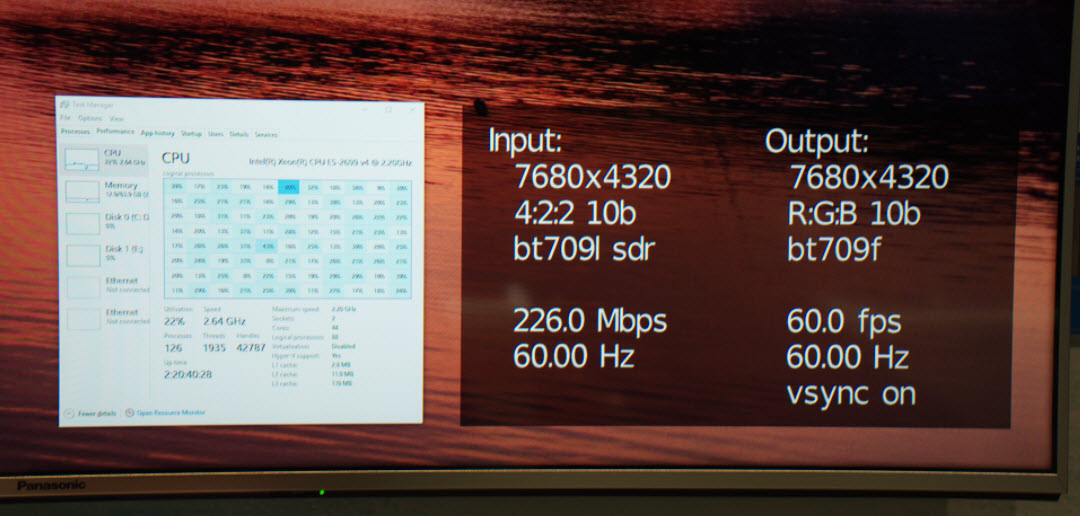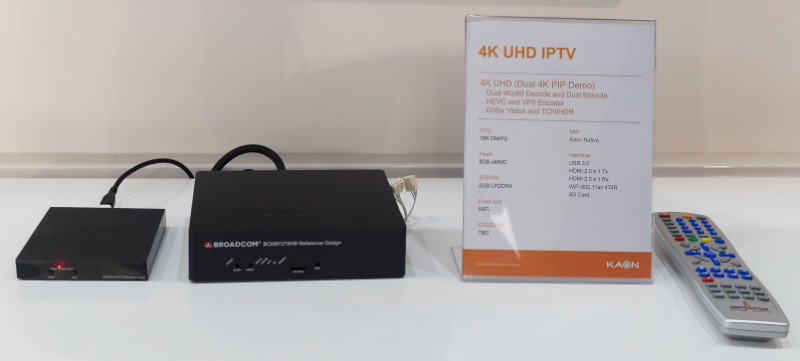Eyevis was showing its Unilumin-based LED systems for broadcasters. As we reported on from the AMD booth, the company also had a special system that used an extra camera mounted below a studio camera and a special pattern on the studio floor to track the position of the main camera. This allows the camera to be accurately positioned within the 3D space of the studio and allowed very accurate mapping of 3D virtual content on the images using the Ventuz live 3D rendering system (AMD Hosts Ventuz for Fast 3D)
HDR for All was the name of the initiative from the UHD Forum which, along with the UHD Alliance, is working on the development of the UltraHD ecosystem. The group was showing a “world’s first” linear UltraHD HDR TV transmission provided by KPN and using PQ. At the event, the Forum gave a masterclass. A lack of time meant that we couldn’t attend, but the slides are freely available for download and there is a video of the talk (not much short of 2 hours) here.
Intel was showing partners in video production on its booth, with an emphasis on codecs. It also had a VR demo. Spin Digital was showing that Intel’s 10 core i9 processor could be used to encode and decode 8K video on a PC. The company can support 8Kp120, 4:2:0 with 10 bit on its player and the company said that as spatial resolution goes up, temporal resolution also has to increase to maintain performance. As well as the HFR version, the company was showing 8Kp60 compression in 4:4:$ and with 12 bits of colour for professional production. Spin has also been developing multi-stream, single PC decoders that can support three 8Kp60 videos or 14 4Kp60 streams. Beamr was also on the booth and showing its new Vanguard Codec.
 Spin digital was showing its codec running on an Intel system. Image:Meko
Spin digital was showing its codec running on an Intel system. Image:Meko
Intel was also showing some of its live video for sports technology that is now being used in 11 stadiums in the US and can support up to 36 cameras, the streams from which can be stitched in real time.
Kaon was showing its home gateways for FTTH, G.Fast or Docsis applications. It also had a Broadcom-based box that can support dual UltraHD decoding and using the HEVC or VP9 codec for transcoding. There is support for HLG, HDR10, Dolby Vision and also the Technicolor HDR scheme. It uses Kaon’s own middleware.
 Kaon’s Dual UHD STB can support the Technicolor HDR Scheme. Image:Meko
Kaon’s Dual UHD STB can support the Technicolor HDR Scheme. Image:Meko
Matrox was showing a new IP-based KVM system (the Extio 3) which has very low latency and can support 4KP60 resolution with 4:4:4 quality, so suitable for graphics (which don’t react well to sub-sampling to 4:2:2 or 4:2:0). The system has latency of less than 50ms and can run over a 1Gbps network, although care needs to be taken not to ‘challenge the switch’. The system can support 1:N control of multiple remote systems and is based on the well developed H.264 technology that Matrox has been developing for a number of years. There are two versions, one for up to four FullHD displays, or a single 4K display, and another that supports dual FullHD displays.
There are stand-alone versions and also a card-based system so that the KVMs can be put in a chassis. The cards bypass the bus, so avoid the limiting that can come from bus loading.
 Matrox’s new Extio 3 IP KVM can work over any 1GB network. Image:Meko
Matrox’s new Extio 3 IP KVM can work over any 1GB network. Image:Meko

